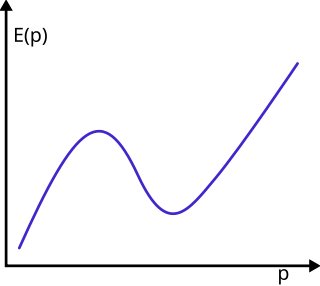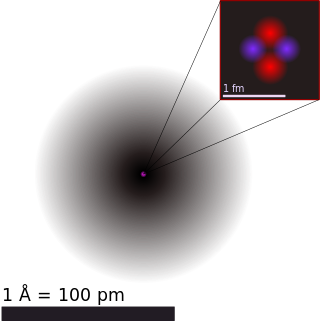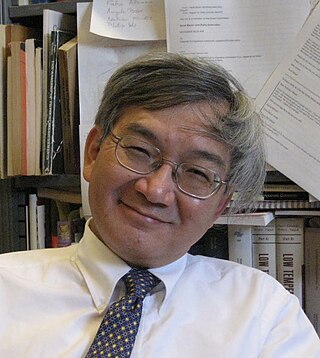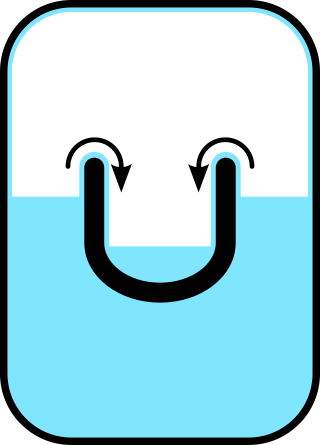Macroscopic theory
Thermodynamics
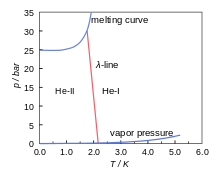
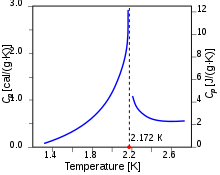

Figure 1 is the phase diagram of 4He. [19] It is a pressure-temperature (p-T) diagram indicating the solid and liquid regions separated by the melting curve (between the liquid and solid state) and the liquid and gas region, separated by the vapor-pressure line. This latter ends in the critical point where the difference between gas and liquid disappears. The diagram shows the remarkable property that 4He is liquid even at absolute zero. 4He is only solid at pressures above 25 bar.
Figure 1 also shows the λ-line. This is the line that separates two fluid regions in the phase diagram indicated by He-I and He-II. In the He-I region the helium behaves like a normal fluid; in the He-II region the helium is superfluid.
The name lambda-line comes from the specific heat – temperature plot which has the shape of the Greek letter λ. [20] [21] See figure 2, which shows a peak at 2.172 K, the so-called λ-point of 4He.
Below the lambda line the liquid can be described by the so-called two-fluid model. It behaves as if it consists of two components: a normal component, which behaves like a normal fluid, and a superfluid component with zero viscosity and zero entropy. The ratios of the respective densities ρn/ρ and ρs/ρ, with ρn (ρs) the density of the normal (superfluid) component, and ρ (the total density), depends on temperature and is represented in figure 3. [22] By lowering the temperature, the fraction of the superfluid density increases from zero at Tλ to one at zero kelvins. Below 1 K the helium is almost completely superfluid.
It is possible to create density waves of the normal component (and hence of the superfluid component since ρn + ρs = constant) which are similar to ordinary sound waves. This effect is called second sound. Due to the temperature dependence of ρn (figure 3) these waves in ρn are also temperature waves.

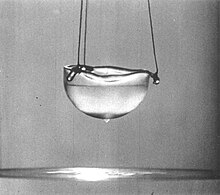
Superfluid hydrodynamics
The equation of motion for the superfluid component, in a somewhat simplified form, [23] is given by Newton's law
The mass M4 is the molar mass of 4He, and is the velocity of the superfluid component. The time derivative is the so-called hydrodynamic derivative, i.e. the rate of increase of the velocity when moving with the fluid. In the case of superfluid 4He in the gravitational field the force is given by [24] [25]
In this expression μ is the molar chemical potential, g the gravitational acceleration, and z the vertical coordinate. Thus we get the equation which states that the thermodynamics of a certain constant will be amplified by the force of the natural gravitational acceleration
- (1)
Eq. (1) only holds if vs is below a certain critical value, which usually is determined by the diameter of the flow channel. [26] [27]
In classical mechanics the force is often the gradient of a potential energy. Eq. (1) shows that, in the case of the superfluid component, the force contains a term due to the gradient of the chemical potential. This is the origin of the remarkable properties of He-II such as the fountain effect.

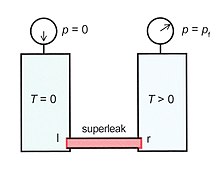

Fountain pressure
In order to rewrite Eq. (1) in more familiar form we use the general formula
- (2)
Here Sm is the molar entropy and Vm the molar volume. With Eq. (2) μ(p,T) can be found by a line integration in the p-T plane. First we integrate from the origin (0,0) to (p,0), so at T =0. Next we integrate from (p,0) to (p,T), so with constant pressure (see figure 6). In the first integral dT=0 and in the second dp=0. With Eq. (2) we obtain
- (3)
We are interested only in cases where p is small so that Vm is practically constant. So
- (4)
where Vm0 is the molar volume of the liquid at T =0 and p =0. The other term in Eq. (3) is also written as a product of Vm0 and a quantity pf which has the dimension of pressure
- (5)
The pressure pf is called the fountain pressure. It can be calculated from the entropy of 4He which, in turn, can be calculated from the heat capacity. For T =Tλ the fountain pressure is equal to 0.692 bar. With a density of liquid helium of 125 kg/m3 and g = 9.8 m/s2 this corresponds with a liquid-helium column of 56 meter height. So, in many experiments, the fountain pressure has a bigger effect on the motion of the superfluid helium than gravity.
With Eqs. (4) and (5) , Eq. (3) obtains the form
- (6)
Substitution of Eq. (6) in (1) gives
- (7)
with ρ0 = M4/Vm0 the density of liquid 4He at zero pressure and temperature.
Eq. (7) shows that the superfluid component is accelerated by gradients in the pressure and in the gravitational field, as usual, but also by a gradient in the fountain pressure.
So far Eq. (5) has only mathematical meaning, but in special experimental arrangements pf can show up as a real pressure. Figure 7 shows two vessels both containing He-II. The left vessel is supposed to be at zero kelvins (Tl=0) and zero pressure (pl = 0). The vessels are connected by a so-called superleak. This is a tube, filled with a very fine powder, so the flow of the normal component is blocked. However, the superfluid component can flow through this superleak without any problem (below a critical velocity of about 20 cm/s). In the steady state vs=0 so Eq. (7) implies
- (8)
where the index l (r) applies to the left (right) side of the superleak. In this particular case pl = 0, zl = zr, and pfl = 0 (since Tl = 0). Consequently,
This means that the pressure in the right vessel is equal to the fountain pressure at Tr.
In an experiment, arranged as in figure 8, a fountain can be created. The fountain effect is used to drive the circulation of 3He in dilution refrigerators. [28] [29]

Heat transport
Figure 9 depicts a heat-conduction experiment between two temperatures TH and TL connected by a tube filled with He-II. When heat is applied to the hot end a pressure builds up at the hot end according to Eq. (7) . This pressure drives the normal component from the hot end to the cold end according to
- (9)
Here ηn is the viscosity of the normal component, [30] Z some geometrical factor, and the volume flow. The normal flow is balanced by a flow of the superfluid component from the cold to the hot end. At the end sections a normal to superfluid conversion takes place and vice versa. So heat is transported, not by heat conduction, but by convection. This kind of heat transport is very effective, so the thermal conductivity of He-II is very much better than the best materials. The situation is comparable with heat pipes where heat is transported via gas–liquid conversion. The high thermal conductivity of He-II is applied for stabilizing superconducting magnets such as in the Large Hadron Collider at CERN.
















